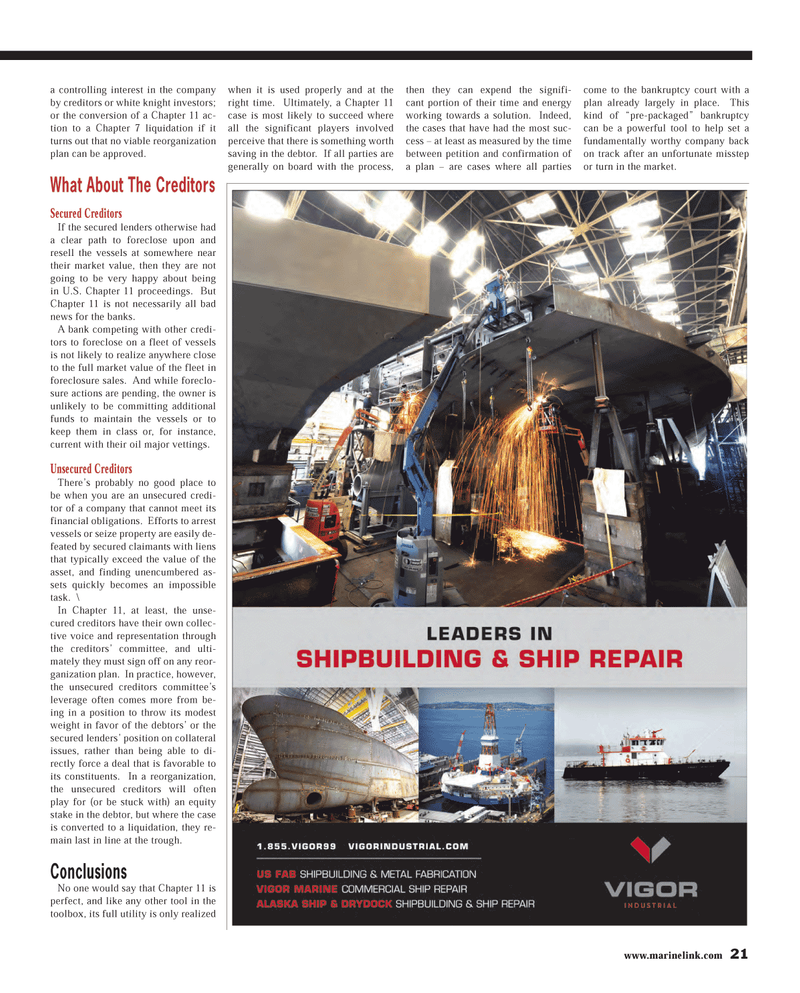
Page 21: of Maritime Reporter Magazine (April 2013)
Offshore Energy Edition
Read this page in Pdf, Flash or Html5 edition of April 2013 Maritime Reporter Magazine
www.marinelink.com 21a controlling interest in the company by creditors or white knight investors; or the conversion of a Chapter 11 ac- tion to a Chapter 7 liquidation if it turns out that no viable reorganization plan can be approved.What About The Creditors Secured Creditors If the secured lenders otherwise had a clear path to foreclose upon and resell the vessels at somewhere near their market value, then they are not going to be very happy about being in U.S. Chapter 11 proceedings. But Chapter 11 is not necessarily all bad news for the banks. A bank competing with other credi- tors to foreclose on a fleet of vessels is not likely to realize anywhere close to the full market value of the fleet in foreclosure sales. And while foreclo- sure actions are pending, the owner is unlikely to be committing additional funds to maintain the vessels or to keep them in class or, for instance, current with their oil major vettings.Unsecured Creditors There?s probably no good place to be when you are an unsecured credi-tor of a company that cannot meet its financial obligations. Efforts to arrest vessels or seize property are easily de-feated by secured claimants with liens that typically exceed the value of the asset, and finding unencumbered as-sets quickly becomes an impossible task. \In Chapter 11, at least, the unse- cured creditors have their own collec-tive voice and representation through the creditors? committee, and ulti- mately they must sign off on any reor- ganization plan. In practice, however, the unsecured creditors committee?s leverage often comes more from be-ing in a position to throw its modest weight in favor of the debtors? or the secured lenders? position on collateral issues, rather than being able to di-rectly force a deal that is favorable to its constituents. In a reorganization, the unsecured creditors will often play for (or be stuck with) an equity stake in the debtor, but where the case is converted to a liquidation, they re-main last in line at the trough.ConclusionsNo one would say that Chapter 11 is perfect, and like any other tool in the toolbox, its full utility is only realized when it is used properly and at the right time. Ultimately, a Chapter 11 case is most likely to succeed where all the significant players involved perceive that there is something worth saving in the debtor. If all parties are generally on board with the process, then they can expend the signifi-cant portion of their time and energy working towards a solution. Indeed, the cases that have had the most suc-cess ? at least as measured by the time between petition and confirmation of a plan ? are cases where all parties come to the bankruptcy court with a plan already largely in place. This kind of ?pre-packaged? bankruptcy can be a powerful tool to help set a fundamentally worthy company back on track after an unfortunate misstep or turn in the market.MR #4 (18-25).indd 21MR #4 (18-25).indd 214/5/2013 10:44:27 AM4/5/2013 10:44:27 AM

 20
20

 22
22
